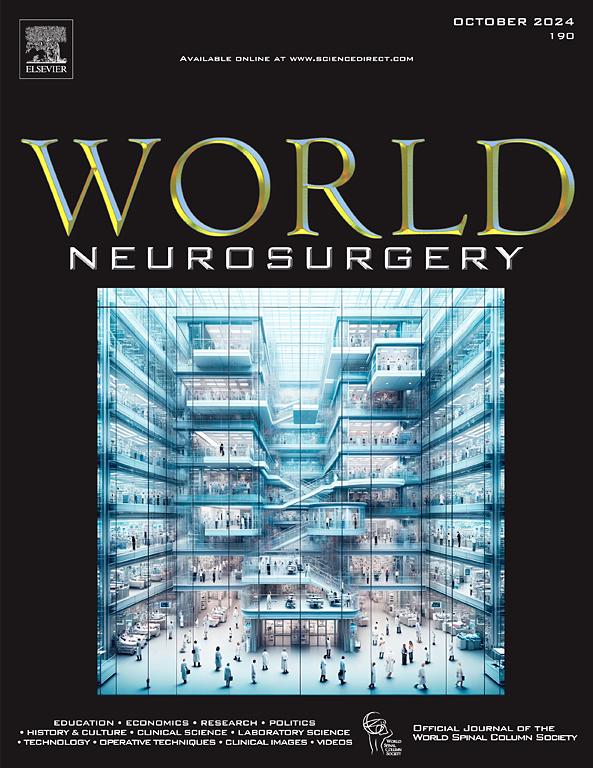A Population-Based Cohort Study of Glioblastoma (World Health Organization Grade 4 Gliomas) in Ontario: Continued Improvement in Care over 25 Years
IF 1.9
4区 医学
Q3 CLINICAL NEUROLOGY
引用次数: 0
Abstract
Objective
Grade 4 glioma is the most common and fatal primary malignant brain tumor in adults. We sought to describe the evolution of care and survival of patients with glioblastoma in a single-payer Canadian provincial health care system over a 24-year period.
Methods
Adult patients >18 years old with pathologically or clinically diagnosed glioblastoma (based on fourth or earlier edition of World Health Organization classification) in Ontario between 1994 and 2018 were identified and followed until death or study end point of 2 years through provincial administrative health data. Patient characteristics, type of treatment, survival, and time spent in the hospital were compared across time periods, age groups, and centers.
Results
We included 9487 patients with glioblastoma treated from 1994 to 2018. Median survival and 2-year survival rate improved over the study period from 6.4 to 9.4 months and 10% to 18%, respectively. Older age was associated with shorter survival (median survival of 12 months at 65–74 years vs. 3 months at > 85 years), less aggressive therapy, and a higher proportion of remaining lifetime spent in the hospital (more than one third of patients >75 years spend ≥50% their remaining survival in hospital). Time in the hospital decreased by 8.9 days (95% confidence interval 8.53–9.25) over the study period. Significant heterogeneity exists in patient management and outcome between regional treatment centers.
Conclusions
The real-world prognosis for grade 4 glioma remains poor. However, an increased proportion of patients receiving maximal therapy is associated with a small but meaningful improvement in survival and decreased time in the hospital for all but the oldest patients.
安大略省一项基于人群的胶质母细胞瘤(WHO 4级胶质瘤)队列研究:25年来护理的持续改善
目的:四级胶质瘤是成人最常见、最致命的原发性恶性脑肿瘤。我们试图描述在单一付款人加拿大省级医疗保健系统中24年期间胶质母细胞瘤患者护理和生存的演变。方法:通过省级行政卫生数据确定1994年至2018年间安大略省病理或临床诊断为胶质母细胞瘤(基于WHO第4版或更早版本的分类)的成年患者,并随访至死亡或两年的研究终点。患者特征、治疗类型、生存率和住院时间在不同时间段、年龄组和中心之间进行比较。结果:我们纳入了1994年至2018年治疗的9,487例胶质母细胞瘤患者。研究期间,中位生存期和2年生存率分别从6.4个月提高到9.4个月,从10%提高到18%。年龄越大,生存期越短(65-74岁时中位生存期为12个月,而bb0 - 85岁时中位生存期为3个月),治疗越不积极,剩余生命在医院度过的比例越高(> /3的> - 75岁患者在医院度过的剩余生存期≥50%)。在研究期间,住院时间减少了8.9天(95%CI 8.53-9.25)。区域治疗中心之间的患者管理和预后存在显著的异质性。结论:4级胶质瘤的实际预后仍然很差。然而,接受最大限度治疗的患者比例的增加与生存率的小幅但有意义的改善和住院时间的缩短有关,除了大多数老年患者。
本文章由计算机程序翻译,如有差异,请以英文原文为准。
求助全文
约1分钟内获得全文
求助全文
来源期刊

World neurosurgery
CLINICAL NEUROLOGY-SURGERY
CiteScore
3.90
自引率
15.00%
发文量
1765
审稿时长
47 days
期刊介绍:
World Neurosurgery has an open access mirror journal World Neurosurgery: X, sharing the same aims and scope, editorial team, submission system and rigorous peer review.
The journal''s mission is to:
-To provide a first-class international forum and a 2-way conduit for dialogue that is relevant to neurosurgeons and providers who care for neurosurgery patients. The categories of the exchanged information include clinical and basic science, as well as global information that provide social, political, educational, economic, cultural or societal insights and knowledge that are of significance and relevance to worldwide neurosurgery patient care.
-To act as a primary intellectual catalyst for the stimulation of creativity, the creation of new knowledge, and the enhancement of quality neurosurgical care worldwide.
-To provide a forum for communication that enriches the lives of all neurosurgeons and their colleagues; and, in so doing, enriches the lives of their patients.
Topics to be addressed in World Neurosurgery include: EDUCATION, ECONOMICS, RESEARCH, POLITICS, HISTORY, CULTURE, CLINICAL SCIENCE, LABORATORY SCIENCE, TECHNOLOGY, OPERATIVE TECHNIQUES, CLINICAL IMAGES, VIDEOS
 求助内容:
求助内容: 应助结果提醒方式:
应助结果提醒方式:


